by Samir Raafat
Egyptian Mail, September 11, 1993, updated 1996
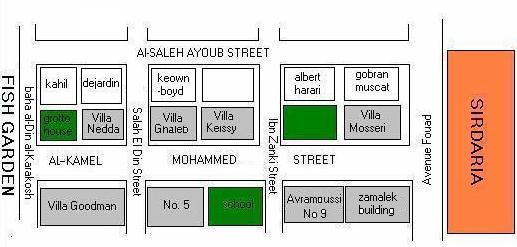
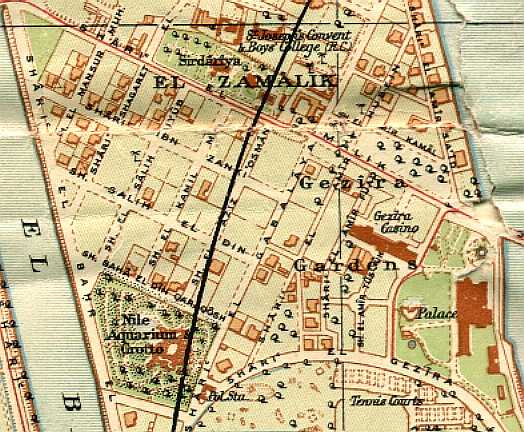
|
|
|
|
|
|
EGY.COM - JUDAICA
|
|
by Samir Raafat
Egyptian Mail, September 11, 1993, updated 1996


While tortured relations between Israel and its Arab neighbors continue to make daily headlines, in the days before the creation of Israel, hawks and doves of the Zionist illuminati were either residents or frequent visitors to Egypt. And this is where a single Zamalek street can relate part of this forgotten story.
Kamel Mohammed Street stretches northwards from Hadikat Al Asmak (Fish Garden), up to 26th of July Street intersecting Salah Al Din and Ibn Zanki streets along the way.
Early in the 20th century, the areas flanking Kamel Mohammed Street were empty fields. Subsequently, and as the island joined the urban sprawl, these were carved up into 12 plots of half an acre each for the construction of villas with gardens. Few of the first houses--some of the island's finest--survived the urban onslaught of the 1970s. Yet, in the days when Cairo's population was below two million, Kamel Mohammed was just another shaded residential roadway with a handful of inhabitants.
Large villas stood at opposite ends of Kamel Mohammed Street. If villas numbers 1, 3 and 4 overlooking Hadikat Al Asmak at the south end are gone, the villa at the northe end of the street is still standing somewhat neglected. This is No. 12, a white neo-Islamic villa (today earmarked for annihilation) surrounded by a shrunken garden that fronts 26th of July Street and what was once the Sirdaria.
What had been a villa at No. 1 became an apartment building built during the interwar period. It is there that banker-businessman Hector de Cattaui died. Like his father, Moise Cattaui Pasha, the long-standing president of Cairo's Sephardi community, Hector and his immediate family had little to do with Zionism. For generations they graced the top echelons of Egyptian society and saw no need to exchange gracious living for life on a socialist kibbutz.
Things were however different at No. 3 Kamel Mohammed where Cattaui's cousins lived.
Villa Goodman, which once belonged to an English health inspector in Upper Egypt, was the elected residence of Maitre Aaron Alexander, an affluent Ashkenazi with origins in Znin, Poland.
A successful lawyer at the Mixed and British Consular Courts, Alexander was legal advisor and board member of several British concerns in Egypt including Shell Oil, the Egyptian Delta Land Company, and the English School. His practice at the Savoy Chambers was considered amongst the best in Cairo so that his client roster includes the old Khediva-mother, Messrs. Rothschilds and the Suez Canal Company. Alexander's wife Victoria 'Vicky' Nessim Mosseri was a niece of Moise Cattaui Pasha and a sister of banker-magnate Elie Nessim Mosseri.
The Alexanders and their three children-Arthur-Lionel, Anthony-Nessim and Eileen-led a socially active life. As President of the Rotary Club and a dynamic promoter of Eretz Israel, Alexander's villa was the venue for large receptions and visits by important Zionists including British cabinet minister Isaac Hore-Belisha and Chaim Weizmann both of whom dropped by whenever in Cairo. In fact, Maitre Aaron often accompanied Weizmann during his meetings with Egyptian government officials.
Alexander and his brother Morris, an Alexandria advocate, came to Egypt from Cape Town in 1913. Both married into the local cosmopolitan Jewry and, like many Eastern European co-religionists from South Africa, the Alexanders were obsessed with the creation of a homeland in Palestine.
Albeit a member of the assimilated elite of Egypt's haute Juiverie, the Egyptian-born Vicky Alexander (nee Mosseri) began to see things Aaron's way. Soon enough she became co-chairperson of the annual WIZO (Women International Zionist Organization) bazaar held at Groppi's or Shepheard's Hotel. These were well-attended fund-raisers attracting Egypt's best society ladies of all faiths.
Although wary of Zionist intentions successive Egyptian governments tolerated WIZO's existence along with its auxiliary agencies.
Despite the publication of Lord Balfour's November 2, 1917 letter to Lord Rothschild conveying His Majesty's government's view to the establishment in Palestine of a national home for the Jewish people, Zionism was not yet a threat in Egypt. It was regarded by Egypt's unsuspecting intelligentsia as little more than the hopeless yearning for an ancestral homeland by groups of scattered Jews. In other words, their cause was commensurate to Red Indians aspiring to take over New Jersey. None suspected the Eurojew knew exactly what he was about... that he was simply marking time towards something wholly Jewish. The Jewish State of Israel.
Local politicians meanwhile found comfort in the fact that Jews in Palestine represented a mere fraction of the indigenous population owning less than 10 percent of the entire territory. What, therefore, was all the brouhaha about?
Any serious misgivings by the more skeptical Egyptian statesmen were countered by multiple promises from the British Foreign Office: Borders of British Mandated Palestine and the status quo of its overwhelming Arab Muslim-Christian majority were guaranteed by His Majesty's government and thus in safe hands. Aaron Alexander and his fantasizing crowd were free to aspire and hallucinate as they pleased. Yet Alexander heard contradictory promises form his British friends: The homeland would soon become a state.
Maitre Alexander died of a fatal heart attack at age 58 on September 12, 1945 while hosting a dinner for visiting colleagues at Cairo's posh Mohammed Ali Club. He would never learn of the creation of Israel and the several bloody conflicts that followed. Neither would he know that after resting for several years in the Mosseri graveyard in Bassateen on the edge of Cairo, his remains would be exhumed and shipped to the United Kingdom. Even though he couldn't claim an iota of Anglo-Saxon ancestry, Aaron had always felt British.
A few years after Maitre Alexander's death, Villa Goodman was sold, demolished and replaced with the twin Wadie Saad Buildings designed by Albert Zananiri.
As evidenced by their English School report cards, Alexander's children were exceptionally bright. It was expected therefore for Eileen and her siblings to pursue their studies in the UK, she at Girton College Cambridge and the brothers at something equally distinctive.
Not overly concerned about her daughter's academic achievements, Vicky aalong with Eileen's Mosseri aunts waited in eager anticipation for another kind of newsflash from England. They learned through the international Jewish grapevine that Eileen had met several eligible bachelors.
Singled out was Aubrey Eban (born Solomon). For sure he had the perfect credentials. His Anglo-Saxon education was enough reason to be sought after by the Anglophile Levantine bourgeoisie of Egypt. And for someone like Vicky longing to marry off her Jewish princess, the fact Eban's father had been a prominent Zionist in the Cape was more than mere coincidence. Perhaps he had known Alexander Sr.? Their references were practically identical.

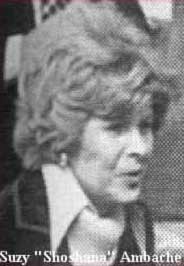
Queen Farida and Suzy Ambache
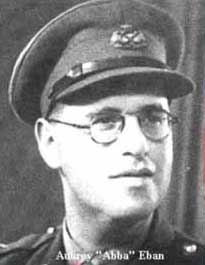
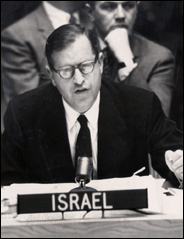
Aba Eban
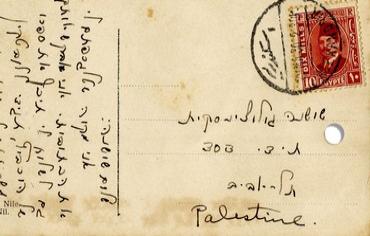
Egyptian postcard from Eban's future boss Golda Meir to a friend in Palestine dated "Alexandria May 1930"
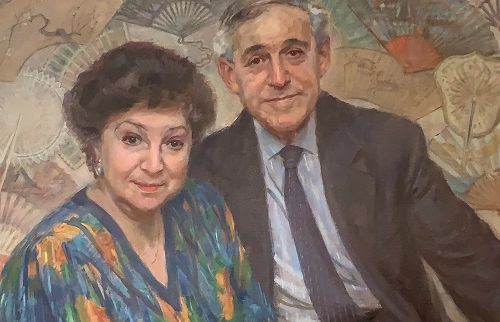
Helen Victor Adda (granddaughter of Joseph Nessim Mosseri and Jeanne Aghion)
with husband Anthony-Nessim Alexander (son of Victoria Nessim Mosseri & Aaron Alexander)
Despite the absence of any romantic attachment between Aubrey and Eileen, in her innermost fancy Vicky Alexander thought she heard wedding bells. Fate intervened on Vicky's behalf when Eban, now an officer in the British Army, arrived in Cairo in February 1942. But a few months later, news from London announced Eileen's engagement to a Cambridge colleague, Gershon Ellenbogen. They were married in London on March 26, 1944, where the Alexanders kept house on Marley Road, Swiss Cottage.
In April 1943, Eban was again posted in Cairo this time to the office of the minister of state for the Middle East, first under Richard Casey, and then under Lord Moyne.
Lord Moyne was murdered by two Jewish terrorists in November 1944. His drastic demise may have been a source of discomfort for Major Eban. Once again, he had to come to terms with that annoying split allegiance syndrome. On the one hand his patrician British superiors represented everything the young officer liked to emulate, while on the other, there were these two young men with a mission. Not unlike Eban, they viewed the redemption of Eretz Israel in political rather than religious terms.
Yet it was never a question of Eban's English upbringing being tempered by his sense of Zionist responsibilities. The short of it was that an uninterrupted 30 year exposure to the British way of life amounted to naught when it came to race and convictions. "I belong there, but I have to be here" as he put it himself in one of his writings.
For a few weeks, Aubrey Eban and Gershon Ellenbogen, his erstwhile rival in love, rejoined British military intelligence in the Middle East. They shared flat No. 10 in the handsome "Zamalek Building" owned by Basile Cosbar and located at No. 11 Kamel Mohammed Street. (Cosbar's son Camille owned the nearby villa No. 6 Ibn Zanki). The Alexanders' old cook, Adele and their manservant Saiid looked after them. It wasn't long after his arrival that Eban became madly enamored with the proverbial girl-next-door-or at least across the street.
Opposite Zamalek Building lived the Ambaches, a Yishuv family of East European ancestry. Engineer Simha Ambache and his wife (born Steinberg) had three daughters and a son, Nahman. They had come to Cairo from the Canal Zone where Simha ran a prosperous contracting business. Their home at No. 12 Kamel Mohammed Street belonged to the late Jacques Mosseri, another one of Vicky Alexander's relations.
Ever since his Cambridge days, Jacques Mosseri had been an impassioned supporter of Chaim Weizmann. Upon returning to Cairo in 1913, Jacques headed the Zionist organization in Egypt. Because of his premature death in 1934, he never saw the fulfillment of his dream or the swearing in of his champion as Israel's first president.
On January 1, 1945 Aubrey Eban was engaged to the Ismailia-born Suzy Ambache. She had just graduated from the American University in Cairo with a Bachelors of Arts in Social Science. Senator Haim Nahum Effendi solemnized their subsequent March wedding. In his grand blue and black robes Egypt's chief rabbi was described as "something out of a Hollywood movie."
Eban's wedding assembled the future leadership of Israel. Perhaps it had something to do with some Zionist conclave in Cairo at the time.
Standing side by side at Eban's wedding reception were Egyptian notables, the pillars of the local Jewry, senior British officers, and Cairo's leading and visiting Zionists. Among them were Israel's future Prime Minister David Ben Gurion and his wife Paula. Also present was Theodor 'Teddy' Kollek a Viennese Jew destined to become the mayor of West Jerusalem.
The newlyweds spent their honeymoon touring ancient sites in Luxor and Aswan. Destiny soon took them all over the world before settling in Herzlia outside Tel Aviv where they live in comfortable retirement. When he is not touring American television studios or attending UJA (United Jewish Appeal) dinners Eban writes books and compelling memoirs.
It was on December 25, 1977 that Suzy Ambache returned to her birthplace during the visit to Ismailia of Israeli Prime Minister Menachem Begin. He asked her to come along when he learned she was born there. Although not present at the historic Begin-Sadat meeting, Eban had by now fulfilled most of his ambitions. In conformity to his beliefs he had Hebraized his name to Aba. It was therefore as Aba Eban that he raised the Star of David at the United Nations in New York in May 1949, symbolizing the creation of the Jewish State.
Almost a year after the Eban-Ambache wedding, a second Kamel Mohammed resident married another rising anglophile Eastern European Zionist serving in the British Army. While visiting the Ambache home in Zamalek, the groom-to-be was smitten by Suzy's younger sister Aura. Aura's marriage to Vivian 'Chaim' Herzog took place in Palestine a few months after their initial meeting.
"It was love at first sight," she would fondly recall in an interview many years later. By which time Aura had become her country's first lady. The son of Isaac Herzog, former chief rabbi of Ireland (also the first Ashkenazi Chief Rabbi of Israel), was the 6th president of the State of Israel in 1983.
The Alexanders, the Ambaches and the Cattauis were not the only wealthy Jewish residents on Kamel Mohammed Street. There was the Salonika-born Ovadia Mercado Salem a Sephardi who, as mentioned earlier, had purchased the splendid villa at No. 5 that would later become the Embassy of Canada.
A self-made man who started out as an errand boy at Beinisch Jewelry in Mousky, Salem worked for Lloyds Bank before forming with Alfred Cohen and Alfred Perez his Societé d'Avances Commerciales S.A.E. (Sherket Al Taslifat Al Togareya). Soon enough Salem became principal shareholder in the Chemla Department Stores (ex-Chemla Frères) that was later managed by his son-in-law Youssef Peppo Simha.
Those who recall Monsieur Ovadia or Khawaga Salem as his employees alternately called him, described him as a shrewd operator who recognized a good deal when he saw one. Others claimed he wasn't too popular with insurance companies in view of several doubtful claims. But it would be due to his alleged Zionist sympathies that Ovadia Salem was subsequently interned in Huckstep military base east of Cairo following the first Arab-Israeli War of 1948. This was also when all his assets were summarily frozen except for his villa that was luckily in his wife's (a cousin) name and temporarily leased to a crestfallen Queen Farida following her separation from King Farouk.
Salem was not alone in his internment. With him were some 500 Zionists, an equal number of communists (some of them Jews) and an even larger number of Muslim Brothers. The overflow of prisoners was sent to Al Tor in Sinai and Abu Kir, east of Alexandria. But with the arrival to power of the Wafd Party, things improved dramatically. Consistently treated better than their fellow Muslim Brother inmates, Salem and his colleagues were released with the proviso that those with foreign passports leave Egypt.
Rather than leave, Ovadia Salem who had Egyptian citizenship, chose to remain. With interests in many companies including the famous Misr Group, Ovadia was an accepted pillar of the Cairo business community. When Ovadia Salem died in March 1958 he was living in the Charakian-designed Albert Harari Building at No.11 Ibn Zanki.
Besides upright Egyptian Jews and aspiring East European Zionists on Kamel Mohammed Street during the interwar years, there were plenty of other illustrious residents as well. For starters there was landowner Abdel Hamid Ghaleb Bey, son of Osman Ghaleb Pasha, a former khedivial governor of Cairo. He owned the land at No. 6 Kamel Mohammed. Rather than commission one of the many foreign architects available at the time, Ghaleb Bey hired local contractor Al Hag Morsi and proceeded in 1929 to implement his own drawing of what he perceived to be the ideal home. Four decades later his heirs would lease and then sell the old homestead to the Embassy of Rumania. The new owner, claiming the house had suffered during the October 1992 earthquake, proceed to replace it with an unsavory communist-era-looking chancery.
Contiguous to the Ghalebs was the ornate redbrick house of Mahmoud Fahmi Al Keissy Pasha a former minister of interior. Sometime in the 1980s a grisly vertical building shot up in between the two villas. At about the same time the Libyan government purchased the Keissy Villa annexing it to their adjacent art-deco embassy fronting Saleh Ayyub and Ibn Zanki Streets.
Across the street from the Rumanians still stands Villa Nedda (No. 4) built by tobacco baron Signor Carlo Grassi. Carlo and his wife Nedda were great entertainers always happy to show off their fine art collection. Aside from being the President of the long time Italian chamber of commerce, Grassi was head of the Cairo Fascio before World War 2. Today his house is the Embassy of Morocco.
Between Villa Nedda and the Fish Gardens stands the 1950s Lakah Building that replaced part of Grotto House, a very popular pre World War 1 address.
Two 'bed and breakfasts' were also located on Kamel Mohammed Street: Pension Cromer at the elegant Evangel Avramoussi Building (No. 9) designed by Caligopoulo, and Pension Zamalek at No. 11. Also at No. 11 was the Dutch Legation in Egypt with Baron Bentinck presiding before and during World War 2.
Amazing but true. On one short street lived-not necessarily at the same time but by 1950s-an art-collecting Italian fascist, a Nazi sympathizer, several Zionists, a Dutch baron, an enterprising Judeo-Levantine financier, an Egyptian notable, a minister of interior, a future first lady and a former queen.
|
Reader Comments |
|
|
|
|
|